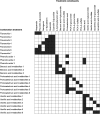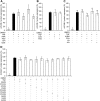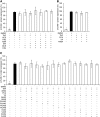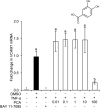Common Phenolic Metabolites of Flavonoids, but Not Their Unmetabolized Precursors, Reduce the Secretion of Vascular Cellular Adhesion Molecules by Human Endothelial Cells
- PMID: 26843586
- PMCID: PMC4763483
- DOI: 10.3945/jn.115.217943
Common Phenolic Metabolites of Flavonoids, but Not Their Unmetabolized Precursors, Reduce the Secretion of Vascular Cellular Adhesion Molecules by Human Endothelial Cells
Abstract
Background: Flavonoids have been implicated in the prevention of cardiovascular disease; however, their mechanisms of action have yet to be elucidated, possibly because most previous in vitro studies have used supraphysiological concentrations of unmetabolized flavonoids, overlooking their more bioavailable phenolic metabolites.
Objective: We aimed to explore the effects of phenolic metabolites and their precursor flavonoids at physiologically achievable concentrations, in isolation and combination, on soluble vascular cellular adhesion molecule-1 (sVCAM-1).
Method: Fourteen phenolic acid metabolites and 6 flavonoids were screened at 1 μM for their relative effects on sVCAM-1 secretion by human umbilical vein endothelial cells stimulated with tumor necrosis factor alpha (TNF-α). The active metabolites were further studied for their response at different concentrations (0.01 μM-100 μM), structure-activity relationships, and effect on vascular cellular adhesion molecule (VCAM)-1 mRNA expression. In addition, the additive activity of the metabolites and flavonoids was investigated by screening 25 unique mixtures at cumulative equimolar concentrations of 1 μM.
Results: Of the 20 compounds screened at 1 μM, inhibition of sVCAM-1 secretion was elicited by 4 phenolic metabolites, of which protocatechuic acid (PCA) was the most active (-17.2%, P = 0.05). Investigations into their responses at different concentrations showed that PCA significantly reduced sVCAM-1 15.2-36.5% between 1 and 100 μM, protocatechuic acid-3-sulfate and isovanillic acid reduced sVCAM-1 levels 12.2-54.7% between 10 and 100 μM, and protocatechuic acid-4-sulfate and isovanillic acid-3-glucuronide reduced sVCAM-1 secretion 27.6% and 42.8%, respectively, only at 100 μM. PCA demonstrated the strongest protein response and was therefore explored for its effect on VCAM-1 mRNA, where 78.4% inhibition was observed only after treatment with 100 μM PCA. Mixtures of the metabolites showed no activity toward sVCAM-1, suggesting no additive activity at 1 μM.
Conclusions: The present findings suggest that metabolism of flavonoids increases their vascular efficacy, resulting in a diversity of structures of varying bioactivity in human endothelial cells.
Keywords: VCAM-1; endothelial; inflammation; metabolism; phase II conjugate; polyphenol.
Conflict of interest statement
Author disclosures: EF Warner, Q Zhang, KS Raheem, D O’Hagan, MA O’Connell, and CD Kay, no conflicts of interest.
Figures





Similar articles
-
Flavonoid metabolites reduce tumor necrosis factor-α secretion to a greater extent than their precursor compounds in human THP-1 monocytes.Mol Nutr Food Res. 2015 Jun;59(6):1143-54. doi: 10.1002/mnfr.201400799. Epub 2015 May 3. Mol Nutr Food Res. 2015. PMID: 25801720 Free PMC article.
-
Anthocyanins and their physiologically relevant metabolites alter the expression of IL-6 and VCAM-1 in CD40L and oxidized LDL challenged vascular endothelial cells.Mol Nutr Food Res. 2015 Jun;59(6):1095-106. doi: 10.1002/mnfr.201400803. Epub 2015 Apr 30. Mol Nutr Food Res. 2015. PMID: 25787755 Free PMC article.
-
Protocatechuic aldehyde suppresses TNF-alpha-induced ICAM-1 and VCAM-1 expression in human umbilical vein endothelial cells.Eur J Pharmacol. 2005 Apr 18;513(1-2):1-8. doi: 10.1016/j.ejphar.2005.01.059. Eur J Pharmacol. 2005. PMID: 15878704
-
Physiologically relevant metabolites of quercetin have no effect on adhesion molecule or chemokine expression in human vascular smooth muscle cells.Atherosclerosis. 2009 Feb;202(2):431-8. doi: 10.1016/j.atherosclerosis.2008.04.040. Epub 2008 May 1. Atherosclerosis. 2009. PMID: 18489909
-
Physiological Concentrations of Blueberry-Derived Phenolic Acids Reduce Monocyte Adhesion to Human Endothelial Cells.Mol Nutr Food Res. 2019 Sep;63(18):e1900478. doi: 10.1002/mnfr.201900478. Epub 2019 Jun 28. Mol Nutr Food Res. 2019. PMID: 31216087
Cited by
-
Exploiting Phenylpropanoid Derivatives to Enhance the Nutraceutical Values of Cereals and Legumes.Front Plant Sci. 2016 Jun 3;7:763. doi: 10.3389/fpls.2016.00763. eCollection 2016. Front Plant Sci. 2016. PMID: 27375635 Free PMC article. Review.
-
Phytochemicals and Traditional Use of Two Southernmost Chilean Berry Fruits: Murta (Ugni molinae Turcz) and Calafate (Berberis buxifolia Lam.).Foods. 2020 Jan 6;9(1):54. doi: 10.3390/foods9010054. Foods. 2020. PMID: 31935880 Free PMC article. Review.
-
Potential Impact of Nutrition on Immune System Recovery from Heavy Exertion: A Metabolomics Perspective.Nutrients. 2017 May 18;9(5):513. doi: 10.3390/nu9050513. Nutrients. 2017. PMID: 28524103 Free PMC article. Review.
-
Going "Green" in the Prevention and Management of Atherothrombotic Diseases: The Role of Dietary Polyphenols.J Clin Med. 2021 Apr 3;10(7):1490. doi: 10.3390/jcm10071490. J Clin Med. 2021. PMID: 33916712 Free PMC article. Review.
-
Anthocyanins and Vascular Health: A Matter of Metabolites.Foods. 2023 Apr 26;12(9):1796. doi: 10.3390/foods12091796. Foods. 2023. PMID: 37174334 Free PMC article. Review.
References
-
- Geleijnse JM, Launer LJ, Van der Kuip DA, Hofman A, Witteman JC. Inverse association of tea and flavonoid intakes with incident myocardial infarction: the Rotterdam Study. Am J Clin Nutr 2002;75:880–6. - PubMed
-
- Mink PJ, Scrafford CG, Barraj LM, Harnack L, Hong CP, Nettleton JA, Jacobs DR Jr. Flavonoid intake and cardiovascular disease mortality: a prospective study in postmenopausal women. Am J Clin Nutr 2007;85:895–909. - PubMed
-
- Barona J, Aristizabal JC, Blesso CN, Volek JS, Fernandez ML. Grape polyphenols reduce blood pressure and increase flow-mediated vasodilation in men with metabolic syndrome. J Nutr 2012;142:1626–32. - PubMed
Publication types
MeSH terms
Substances
Grants and funding
LinkOut - more resources
Full Text Sources
Other Literature Sources
Miscellaneous

